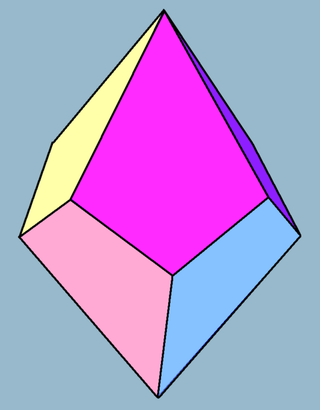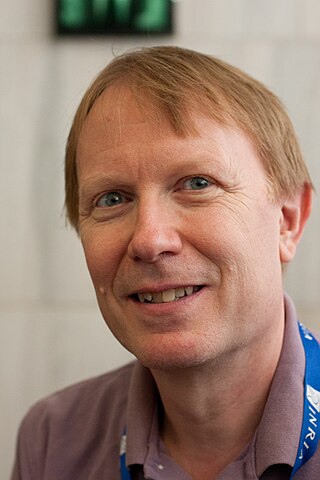Related Research Articles
The Association for Computing Machinery (ACM) is a US-based international learned society for computing. It was founded in 1947 and is the world's largest scientific and educational computing society. The ACM is a non-profit professional membership group, reporting nearly 110,000 student and professional members as of 2022. Its headquarters are in New York City.

A triangulation of a set of points in the Euclidean space is a simplicial complex that covers the convex hull of , and whose vertices belong to . In the plane, triangulations are made up of triangles, together with their edges and vertices. Some authors require that all the points of are vertices of its triangulations. In this case, a triangulation of a set of points in the plane can alternatively be defined as a maximal set of non-crossing edges between points of . In the plane, triangulations are special cases of planar straight-line graphs.
ICALP, the International Colloquium on Automata, Languages, and Programming is an academic conference organized annually by the European Association for Theoretical Computer Science and held in different locations around Europe. Like most theoretical computer science conferences its contributions are strongly peer-reviewed. The articles have appeared in proceedings published by Springer in their Lecture Notes in Computer Science, but beginning in 2016 they are instead published by the Leibniz International Proceedings in Informatics.

In geometry, a tetragonal trapezohedron, or deltohedron, is the second in an infinite series of trapezohedra, which are dual to the antiprisms. It has eight faces, which are congruent kites, and is dual to the square antiprism.
ACM SIGACT or SIGACT is the Association for Computing Machinery Special Interest Group on Algorithms and Computation Theory, whose purpose is support of research in theoretical computer science. It was founded in 1968 by Patrick C. Fischer.

In geometry, a straight skeleton is a method of representing a polygon by a topological skeleton. It is similar in some ways to the medial axis but differs in that the skeleton is composed of straight line segments, while the medial axis of a polygon may involve parabolic curves. However, both are homotopy-equivalent to the underlying polygon.

In discrete geometry, a -set of a finite point set in the Euclidean plane is a subset of elements of that can be strictly separated from the remaining points by a line. More generally, in Euclidean space of higher dimensions, a -set of a finite point set is a subset of elements that can be separated from the remaining points by a hyperplane. In particular, when , the line or hyperplane that separates a -set from the rest of is a halving line or halving plane.

In computer science, the range searching problem consists of processing a set S of objects, in order to determine which objects from S intersect with a query object, called the range. For example, if S is a set of points corresponding to the coordinates of several cities, find the subset of cities within a given range of latitudes and longitudes.

Godfried Theodore Patrick Toussaint was a Canadian computer scientist, a professor of computer science, and the head of the Computer Science Program at New York University Abu Dhabi (NYUAD) in Abu Dhabi, United Arab Emirates. He is considered to be the father of computational geometry in Canada. He did research on various aspects of computational geometry, discrete geometry, and their applications: pattern recognition, motion planning, visualization, knot theory, linkage (mechanical) reconfiguration, the art gallery problem, polygon triangulation, the largest empty circle problem, unimodality, and others. Other interests included meander (art), compass and straightedge constructions, instance-based learning, music information retrieval, and computational music theory.

Leonidas John Guibas is the Paul Pigott Professor of Computer Science and Electrical Engineering at Stanford University. He heads the Geometric Computation group in the Computer Science Department.
Joseph O'Rourke is the Spencer T. and Ann W. Olin Professor of Computer Science at Smith College and the founding chair of the Smith computer science department. His main research interest is computational geometry.
WADS, the Algorithms and Data Structures Symposium, is an international academic conference in the field of computer science, focusing on algorithms and data structures. WADS is held every second year, usually in Canada and always in North America. It is held in alternation with its sister conference, the Scandinavian Symposium and Workshops on Algorithm Theory (SWAT), which is usually held in Scandinavia and always in Northern Europe. Historically, the proceedings of both conferences were published by Springer Verlag through their Lecture Notes in Computer Science series. Springer continues to publish WADS proceedings, but starting in 2016, SWAT proceedings are now published by Dagstuhl through their Leibniz International Proceedings in Informatics.

Joseph S. B. Mitchell is an American computer scientist and mathematician. He is Distinguished Professor and Department Chair of Applied Mathematics and Statistics and Research Professor of Computer Science at Stony Brook University.
Subhash Suri is an Indian-American computer scientist, a professor at the University of California, Santa Barbara. He is known for his research in computational geometry, computer networks, and algorithmic game theory.

Jorge Urrutia Galicia is a Mexican mathematician and computer scientist in the Institute of Mathematics of the National Autonomous University of Mexico (UNAM). His research primarily concerns discrete and computational geometry.
In computational geometry and database theory, a range reporting query asks for a list of the points that match the query. The query is often specified by a geometric shape, containing all the points that should match, and is called a range. Range reporting is a special case of range searching, in which queries may return other kinds of aggregate information about points in a range.

In discrete geometry and computational geometry, the relative convex hull or geodesic convex hull is an analogue of the convex hull for the points inside a simple polygon or a rectifiable simple closed curve.
In computational geometry, the star unfolding of a convex polyhedron is a net obtained by cutting the polyhedron along geodesics through its faces. It has also been called the inward layout of the polyhedron, or the Alexandrov unfolding after Aleksandr Danilovich Aleksandrov, who first considered it.
References
- ↑ Chazelle, Bernard; et al. (1996), "Application Challenges to Computational Geometry: CG Impact Task Force Report", in Chazelle, Bernard; Goodman, Jacob E.; Pollack, Richard (eds.), Advances in Discrete and Computational Geometry: Proceedings of the 1996 AMS-IMS-SIAM Joint Summer Research Conference, Discrete and Computational Geometry–Ten Years Later, July 14–18, 1996, Mount Holyoke College, American Mathematical Soc., ISBN 978-0-8218-0674-6 . Also available as a Princeton University technical report TR-521-96.
- ↑ A brief history of SOCG and ACM, Jeff Erickson (chair, SOCG steering committee), June 5, 2014; discussion SoCG vs ACM.
- ↑ Posting by Jeff Erickson, chair of the SoCG steering committee, July 16, 2014.[ dead link ]
- ↑ Symposium on Computational Geometry, DBLP, accessed 2020-12-30.
- ↑ Society for Computational Geometry Articles of Incorporation, accessed 2019-08-25.
- ↑ "ERA 2010 ranked conference list", Australian Research Council, 2010, archived from the original on 2010-02-08, retrieved 2010-01-20.